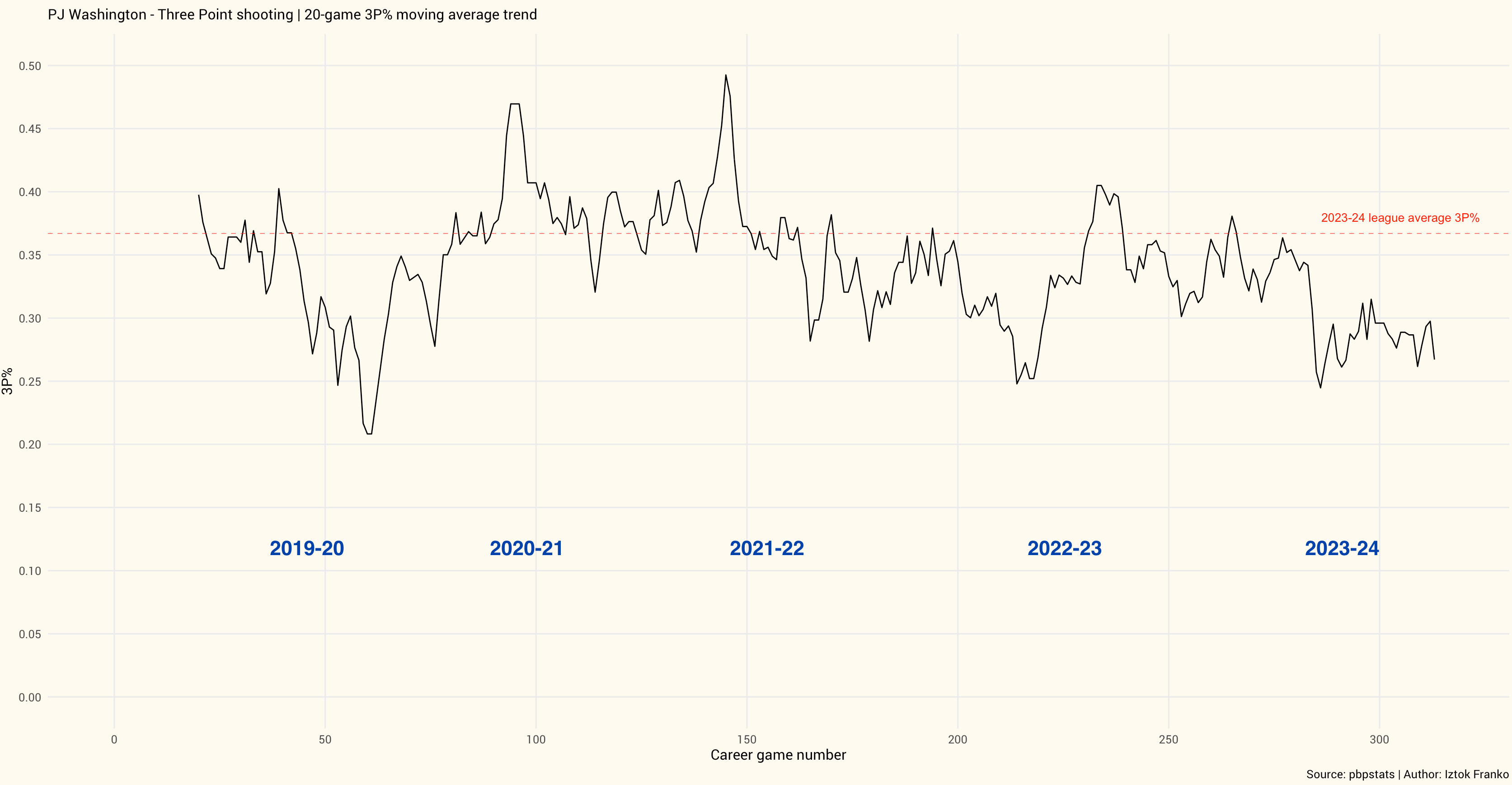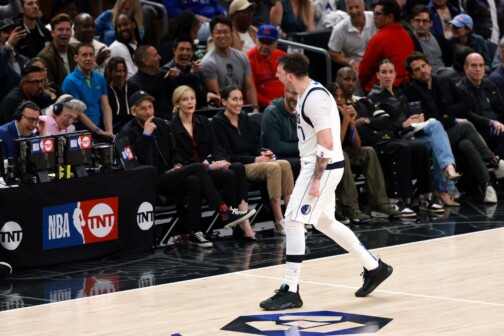The Mavericks’ season may hinge on Paul Jamaine Washington Jr. How you feel about that probably depends on where you fall on the positivity spectrum.
When assessing a former lottery pick out of Kentucky whose potential is as intriguing as his play is inconsistent, optimists will find reasons for excitement, while the glass-half-empty crowd may view his unpredictability as a source of apprehension. However you may feel, the fact remains that less than 10 games into his tenure with the Mavericks, the versatile forward has become the team’s third most important player.
Now, I’m not suggesting that Washington is the team’s third most important player in the long run; rookie center Dereck Lively II has shown more than enough promise and progress to claim that spot. What I’m saying is Washington is the swing piece who will probably determine how far the Mavericks get this season. In nine games since being acquired at the trade deadline, Washington is the only Maverick who has averaged more than 30 minutes per game aside from superstars Luka Doncic and Kyrie Irving. He ranks third in field goal attempts and points per game. Most telling, alongside Doncic and Irving, Washington is the only player who has consistently secured a spot in both the starting and closing lineups. Coincidentally, Washington’s predecessor, Grant Williams, was heralded as the third clear-cut starter and a pivotal piece of the “big group” during the preseason. That experiment ended poorly, and now it’s up to Washington to prove he is a better fit.
That starts by addressing his inconsistency, the issue that has characterized Washington’s NBA career. (I had people from Charlotte referring to him as “P.J. Washinconsistent” when I wrote about him after the trade.) Case in point the trade, I tweeted that the data provided no evidence of Washington being a dependably strong defender during his last three seasons in Charlotte, and my analysis of his defensive film ranged from “awesome” to “lackadaisical.”
So if you are one of those looking to be optimistic, the best possible news I can give you is that, so far in Dallas, he’s delivered sustained, impressive, impactful defense. His length and size are well-suited for the Mavericks’ defensive scheme, which involves rotations funneling opponents toward help at the rim. This setup means that even if Washington is beaten on a close-out or in isolation, it’s less detrimental because Lively, Gafford, or Maxi Kleber is waiting at the back and he has solid defensive instincts to rotate effectively from such situations. Better still, he’s mobile enough to step into that role if it happens to others. All of that compensates for the 25-year-old’s biggest flaw: not being quick enough laterally to be the primary stopper on the wing. He reminds me of a power forward equivalent of Reggie Bullock—not exceptional in any one area but solid enough in most to be considered a good defender.
Washington’s primary strength lies in his versatility. He is capable of switching and holding his own for stretches against various types of players, a strength that is both similar and complementary to that of Kleber. He has held his own as a primary defender against Pascal Siakam, Kevin Durant, and Scottie Barnes, while also switching onto offensive threats as varied as Jayson Tatum, Shai Gilgeous-Alexander, Jarrett Allen, and Victor Wembanyama. Interestingly, the Mavericks have allocated Washington’s playing time in almost equal chunks–about 200 possessions each–across pairings with Lively, Gafford, and Kleber, but have predominantly chosen to play crucial moments of close games with a smaller combination of Washington and the 6-foot-10 Kleber. While sample sizes of 200 possessions are far from being statistically significant, data indicates that the Washington-Kleber pairing is much more effective defensively than combinations with the two more traditional bigs. (In fact, “more effective” is a big understatement, as lineups with Washington and Kleber have a plus-20.6 point differential and defend at an elite rate, allowing only 101.0 points per 100 possessions in 199 possessions per Cleaning the Glass.)
The data is somewhat skewed, because the Mavericks recently faced teams including the Thunder, Suns, Pacers, and Celtics that either prefer playing small or have big men who can shoot, which makes switching a more effective tactic against them. However, it’s also worth noting that switching is what teams gravitate toward in clutch moments and during the playoffs. Switch-and-double is also a scheme the Mavericks mostly apply when teams hunt Doncic, and mobile bigs who can cover ground after that happens are needed to make that work.
Washington’s skill set and fit are among the reasons why, despite the frustration of fans expecting a rim-protecting and rim-running presence for 48 minutes per game, Lively’s minutes have dropped and Gafford’s role diminished, while Kleber has been averaging nearly 25 minutes per game since the trade-deadline reshuffle.
Incorporating Washington’s unusual skill set talents requires adjustment on the offensive end of the court, too. On the plus side, he’s not a low-usage, stand-still, spot-up shooter who can be confined to the corner or limited to catch-and-shoot roles like Kleber or Dorian Finney-Smith, two players who have had the most success playing the big forward position alongside Doncic. But shooting has been the biggest concern regarding Washington’s game since his sophomore NBA season, and that has not improved during his short time in Dallas.
The hope was playing off Doncic might help reverse these trends by providing better looks, but Washington is shooting just 28 percent (14 of 50) from three and a mere 19 percent (4 of 21) from the corners as a Maverick. This is problematic given that his frequency of taking corner threes has more than doubled in the Mavericks’ offense. Washington flashed some hope by making five threes on 10 attempts in a win against the Raptors, which only makes it more frustrating that he shot 33 percent or worse in his other eight games. The potential is there, and the shot looks mechanically sound; it just will not fall. This needs to change, especially when you consider he has averaged almost nine three-point attempts per game over his last three contests.
Washington is much more comfortable scoring by attacking close-outs on the move or operating out of a pick-and-roll, where his versatility is fully showcased. When teams double or trap Doncic, he’s probably the best option as the release valve on a short roll, where he can make a play or finish with his trademark push shot. This was on full display down the stretch in a recent game against the Cavaliers, where Washington made several key plays off of Doncic, including a tough finish at the rim over Allen. This would have been the game-winning bucket if not for the 59-foot buzzer-beater by Max Strus:
So it makes sense that the Mavericks have begun involving Washington more as a pick-and-roll partner for Doncic. He has been Doncic’s most efficient screening partner since the trade deadline, even when compared to highly effective lob threats Lively and Gafford. Here’s where another Washington conundrum comes into play: it seems that to unlock Washington’s offensive arsenal, he fits better alongside another big who can stretch the floor and provide him space to operate in the middle, rather than next to non-shooting bigs like Lively or Gafford, whose best—and perhaps only—effective use on offense is involving them as screeners in the pick-and-roll. Kleber is the closest thing Dallas has to that on its roster right now—he isn’t as aggressive or proficient with his shot to be an ideal fit, but he’s got a long body of work showing he can hit from distance. This is why I believe we’ll continue to see Washington paired with Kleber, or even playing as a small-ball center in close games down the stretch, particularly when opponents opt for smaller lineups and more switching.
But that’s not the long-term answer given Lively’s importance as a defensive hub, rim runner, and passer. And make no mistake: the key to Washington’s future in Dallas will be figuring out how to effectively utilize him alongside Lively on both ends of the court.
It’s possible this resolves itself naturally. Lively is just 20, and he’s already demonstrated that he can expand his game. He’ll get stronger, and with an improved post game will make switching (or defending him with a wing) a less viable strategy. He’s so good that Washington will have to adapt his game to remain the starter. If not, then it’s on Washington to improve his shooting if he wants to avoid coming off the bench.
That’s a problem for tomorrow. Today Dallas sits eighth in the Western Conference standings, scrapping for playoff position. Washington will most likely be on the floor when the Mavericks’ season is on the line, which will require lineup juggling to accommodate him. If Pat Riley’s playoff mantra was “use eight, rotate seven, play six, and trust five,” it appears that Kidd fully trusts only three players, and Washington is one of them. (We’ve seen this change several times this season, which is a discussion for another time.)
That’s yet another example of this team asking a role player to step up a spot or two above his talent level, but we’re only two years removed from that working rather well, when Kleber, Finney-Smith, and Bullock excelled in Dallas’ run to the Western Conference Finals. Washington has shown he can be a defender in the mold of those three, which is a big plus for a team that has been desperately searching for that since Finney-Smith and Bullock left. Whether Washington can do the same on offense, by hitting crucial shots and making decisive plays when it matters most, remains to be seen. Given that aforementioned inconsistency, who’s to say it can’t happen for 20 games, just like it did for Kleber in 2022? The Mavericks’ success in the playoffs will probably hinge on that.
Author








